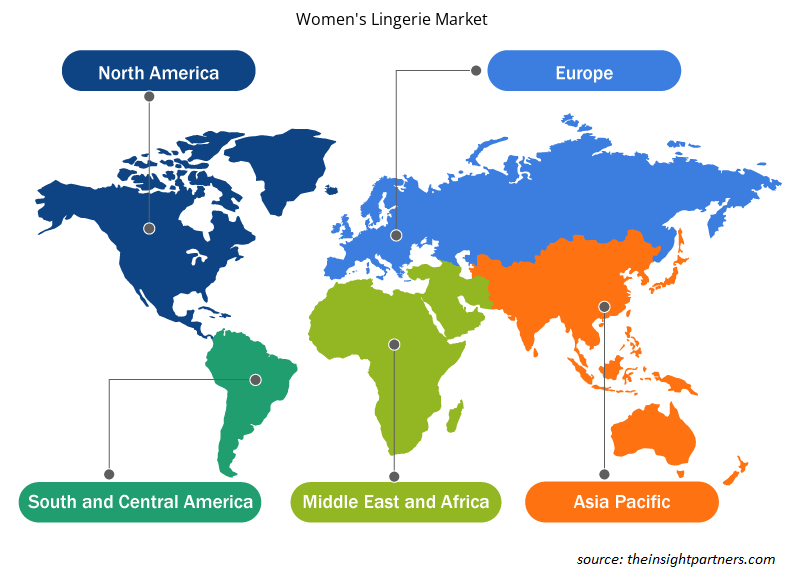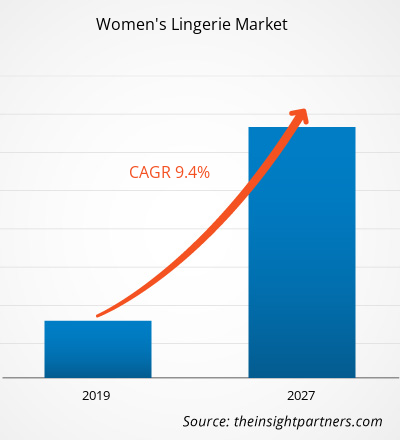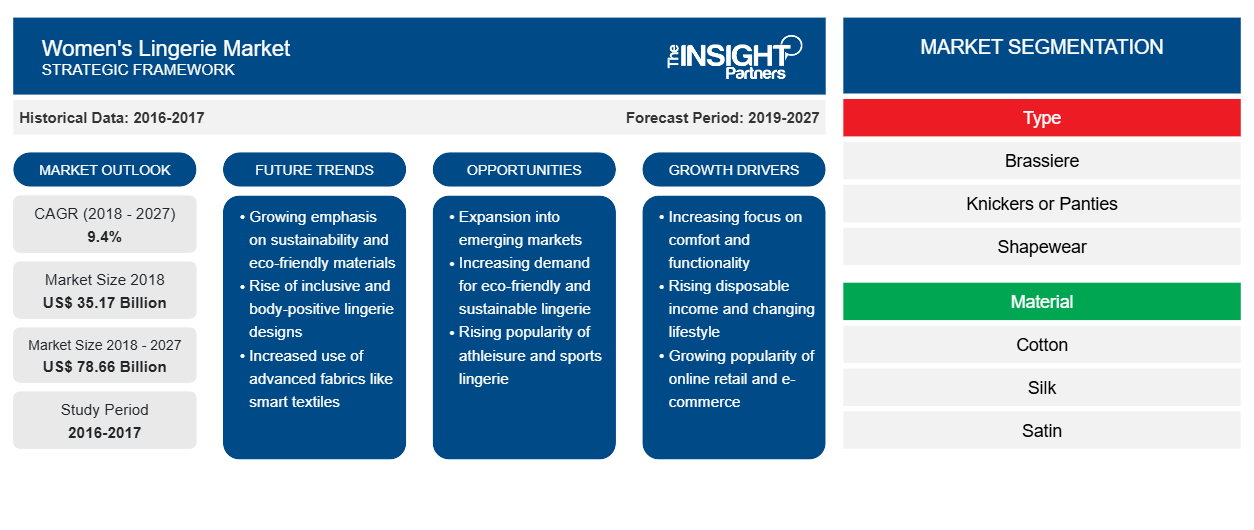بلغت قيمة سوق الملابس الداخلية النسائية 35،169.4 مليون دولار أمريكي في عام 2018، ومن المتوقع أن تصل إلى 78،662.5 مليون دولار أمريكي بحلول عام 2027، بمعدل نمو سنوي مركب قدره 9.4٪ من عام 2019 إلى عام 2027.
كلمة الملابس الداخلية هي مصطلح مأخوذ من اللغة الفرنسية، ويعني الملابس الداخلية، ويستخدم خصيصًا للملابس الداخلية النسائية الأخف وزنًا. الكلمة الفرنسية الأصلية مشتقة من الكلمة الفرنسية القديمة lingerie، والتي تعني الكتان. الملابس الداخلية هي ملابس نسائية مصنوعة من مواد خفيفة الوزن وناعمة وشفافة وقابلة للتمدد. يتميز سوق الملابس الداخلية النسائية بأربعة أنواع رئيسية مثل حمالات الصدر والملابس الداخلية أو الملابس الداخلية والملابس الداخلية المشكل وغيرها. يتميز سوق الملابس الداخلية النسائية بمواد مثل الساتان والقطن والحرير والنايلون وغيرها. يستخدم سوق الملابس الداخلية النسائية قنوات مختلفة لتزويد المستهلكين بالمنتج مثل المتاجر المتخصصة عبر الإنترنت وما إلى ذلك.
من المتوقع أن تكون أمريكا الشمالية أسرع قطاع تجاري نموًا في مجال الملابس الداخلية النسائية العالمية في السنوات القادمة. إن توسيع الوعي بأفضل ما يناسب، وخلق جماهير الألفية، وارتفاع القدرة الشرائية بين النساء مطلوب لدفع السوق خلال فترة التنبؤ. كان تزايد إمكانية الوصول إلى مجموعة واسعة من المنتجات في مناسبات مختلفة لأغراض مختلفة مثل الألعاب، وملابس الزفاف، والملابس القياسية، هو محرك سوق الملابس الداخلية النسائية في المنطقة. وبالمثل، فإن إمكانية الوصول إلى المنتجات على نطاق أوسع، إلى جانب التوسع في دخول القنوات عبر الإنترنت وكذلك غير المتصلة بالإنترنت، هي من بين العوامل الرئيسية التي تدفع سوق الملابس الداخلية النسائية في المنطقة. إن وجود عدد لا يحصى من اللاعبين في السوق مثل L-Brands Inc. و Gap Inc. و Hanesbrands Inc. و Jockey International, Inc. يقدمون تشكيلات هائلة من الملابس الداخلية النسائية، على سبيل المثال، حمالة الصدر المبطنة بلطف، وحمالة الصدر ذات الشريط المصغر، وحمالة الصدر الرياضية ذات الظهر المتسابق، والملابس الداخلية العصرية متوسطة الارتفاع، هو محرك أساسي لسوق الملابس الداخلية النسائية في أمريكا الشمالية.
بدأ تفشي فيروس كورونا المستجد لأول مرة في مدينة ووهان (الصين) خلال شهر ديسمبر 2019 ومنذ ذلك الحين انتشر بسرعة في جميع أنحاء العالم. اعتبارًا من شهر مايو 2020، تعد الصين وإيطاليا وإيران وإسبانيا وجمهورية كوريا وفرنسا وألمانيا والولايات المتحدة من بين الدول الأكثر تضررًا من حيث الحالات المؤكدة والوفيات المبلغ عنها. وفقًا لأحدث أرقام منظمة الصحة العالمية، يوجد حوالي 5728642 حالة مؤكدة و353692 حالة وفاة إجمالية على مستوى العالم. لقد أثر فيروس كورونا المستجد على الاقتصادات والصناعات في مختلف البلدان بسبب عمليات الإغلاق وحظر السفر وإغلاق الشركات. تعد صناعة الأزياء والملابس العالمية واحدة من الصناعات الرئيسية التي تواجه اضطرابات خطيرة مثل انقطاع سلسلة التوريد وإغلاق المكاتب وإغلاق مراكز التسوق والمحلات التجارية ومتاجر التجزئة أو متاجر العلامات التجارية وما إلى ذلك نتيجة لهذا التفشي. على سبيل المثال، تعد الصين المركز العالمي للتصنيع وأكبر مورد للمواد الخام لمختلف الصناعات وهي أيضًا واحدة من أكثر الدول تضررًا. يؤثر إغلاق العديد من المصانع في الصين على سلاسل التوريد العالمية ويؤثر سلبًا على التصنيع وجداول التسليم ومبيعات السلع المختلفة بما في ذلك الملابس. أعلنت العديد من الشركات بالفعل عن تأخيرات محتملة في تسليم المنتجات وانخفاض في مبيعات منتجاتها في المستقبل. بالإضافة إلى ذلك، فإن حظر السفر العالمي الذي فرضته دول في أوروبا وآسيا وأمريكا الشمالية يؤثر على فرص التعاون والشراكات التجارية. ومن المتوقع أن تؤثر كل هذه العوامل سلبًا على صناعة الأزياء والملابس وبالتالي تعمل كعامل مقيد لنمو الأسواق المختلفة المتعلقة بهذه الصناعة في الأشهر المقبلة.
قم بتخصيص هذا التقرير ليناسب متطلباتك
ستحصل على تخصيص لأي تقرير - مجانًا - بما في ذلك أجزاء من هذا التقرير، أو تحليل على مستوى الدولة، وحزمة بيانات Excel، بالإضافة إلى الاستفادة من العروض والخصومات الرائعة للشركات الناشئة والجامعات
- احصل على أهم اتجاهات السوق الرئيسية لهذا التقرير.ستتضمن هذه العينة المجانية تحليلاً للبيانات، بدءًا من اتجاهات السوق وحتى التقديرات والتوقعات.
رؤى السوق
إن تقديم منتجات مبتكرة لتلبية الطلب على الملابس الداخلية العصرية بين العملاء هو ما يدفع نمو السوق عالميًا
هناك اهتمام متزايد بالملابس الداخلية الأنيقة بين السيدات في جميع أنحاء العالم، وذلك بسبب زيادة الوعي تجاه الملابس الداخلية التي تناسب الجسم بشكل أفضل، وتحافظ على الأناقة والراحة. بالإضافة إلى نمو جيل الألفية، فإن زيادة الوعي بالعلامة التجارية، والقدرة الشرائية العالية بين النساء العاملات تخلق فرصة مجزية للاعبين في السوق للوصول إلى المزيد من العملاء من خلال الملابس الداخلية النسائية المبتكرة والملابس الداخلية الحميمة. إن ميل العملاء نحو المنتجات ذات الحواف والنسيج والمواد الفاخرة والألوان الأكثر روعة، يضيف مساهمة إيجابية للمصنعين لتقديم منتجات جديدة في السوق. تنفق معظم النساء من الدول المتقدمة والنامية، مثل الولايات المتحدة وكندا وإيطاليا والمملكة المتحدة وروسيا واليابان والصين والإمارات العربية المتحدة والمملكة العربية السعودية المزيد من الأموال لارتداء الملابس الداخلية العصرية والعصرية لمختلف المناسبات. يمكن للمصنعين والموردين زيادة أقصى قدر من الربح وجذب المتسوقين من خلال تقديم منتجات ذات خصائص أفضل من أي وقت مضى. من المتوقع أن يساعد تطوير المنتجات الإبداعية واستراتيجيات التسويق القوية في النمو العام لسوق الملابس الداخلية النسائية وتعزيز مكانة اللاعبين في السوق في السوق العالمية.
رؤى النوع
بناءً على النوع، يتم تقسيم سوق الملابس الداخلية النسائية إلى حمالات الصدر والملابس الداخلية والملابس الداخلية المشكل وغيرها. في عام 2018، استحوذت شريحة حمالات الصدر على الحصة الكبرى من سوق الملابس الداخلية النسائية العالمية بينما من المتوقع أن ينمو قطاع الآخرين بمعدل نمو سنوي مركب أسرع. يشمل قطاع الآخرين الدمى والقمصان الداخلية والقمصان الداخلية والكورسيهات والصدريات والبدلات الضيقة والدببة وما إلى ذلك. كان التوافر الواسع لهذه الملابس الداخلية النسائية إلى جانب التحول في نمط حياة المستهلك والوعي بالمظهر الجسدي الشخصي من العوامل الرئيسية المعززة لنمو قطاع الآخرين في سوق الملابس الداخلية النسائية.
مادة الرؤية
بناءً على الخامة، يتم تقسيم سوق الملابس الداخلية النسائية إلى القطن والحرير والساتان والنايلون وغيرها. في عام 2018، قادت شريحة القطن السوق بأعلى سوق تليها الحرير. يُعرف الحرير الشارموز بأنه أفخم الأقمشة التي يفضل ارتداؤها بالقرب من الجلد. يتميز بنسج ساتان يمنحه لمعانًا عاليًا ويوفر مظهرًا سائلًا تقريبًا. كان شائعًا في إنتاج الملابس الداخلية منذ أوائل القرن العشرين، ولا يزال يستخدم باستمرار في الملابس الداخلية الراقية. يتم إنشاء العديد من حمالات الصدر المصممة باستخدام مزيج من الحرير / الإسباندكس، والمعروف أيضًا باسم الحرير الشارموز المرن. نسيج البطانة الأكثر استخدامًا هو الحرير الصيني ويمكن أن يكون خيارًا غير مكلف نسبيًا للملابس الداخلية، بما في ذلك الملابس الداخلية. إنه ناعم جدًا بجوار الجسم ورقيق جدًا، لذلك لا يضيف حجمًا. يستخدم كريب الحرير لصنع ملابس النوم الفاخرة والبيجامات والأردية والملابس الداخلية والملابس الليلية.
رؤى حول قنوات التوزيع
بناءً على قناة التوزيع، يتم تقسيم سوق الملابس الداخلية النسائية إلى تجار الجملة والمتاجر المتخصصة والمتاجر عبر الإنترنت وغيرها. وقد قادت المتاجر المتخصصة سوق الملابس الداخلية النسائية العالمية بأعلى حصة سوقية تليها المتاجر الأخرى التي تشمل قنوات التوزيع غير المنظمة. يشمل القطاع الآخر من قنوات توزيع الملابس الداخلية النسائية المتاجر الكبرى والمتاجر المتنوعة والأسواق في الشوارع وما إلى ذلك. يبيع هؤلاء التجار منتجات متعددة، بما في ذلك حمالات الصدر والملابس الداخلية والملابس الداخلية المشكلّة والملابس الداخلية للأطفال والكورسيه والبدلات وغيرها من العلامات التجارية الوطنية والمحلية المختلفة. التكلفة المنخفضة هي العامل الرئيسي الذي يجذب العملاء للشراء من هذه القنوات.
تتبنى الشركات بشكل شائع تطوير المنتجات، وعمليات الدمج والاستحواذ، واستراتيجيات مثل اتفاقية الترخيص والتوزيع، والشراكة مع الموزعين، وعقود المشاريع، وتعزيز قنوات المبيعات والتوزيع لتوسيع بصمتها في جميع أنحاء العالم، مما يؤثر بشكل أكبر على حجم السوق. يشارك اللاعبون في سوق الملابس الداخلية النسائية العالمية بشكل كبير في تطوير المنتجات لتلبية الطلب المتزايد بسبب التفضيلات المتغيرة باستمرار للملابس الداخلية.
نطاق تقرير سوق الملابس الداخلية النسائية
نظرة إقليمية على سوق الملابس الداخلية النسائية
لقد قام المحللون في Insight Partners بشرح الاتجاهات والعوامل الإقليمية المؤثرة على سوق الملابس الداخلية النسائية طوال فترة التوقعات بشكل شامل. يناقش هذا القسم أيضًا قطاعات سوق الملابس الداخلية النسائية والجغرافيا في جميع أنحاء أمريكا الشمالية وأوروبا ومنطقة آسيا والمحيط الهادئ والشرق الأوسط وأفريقيا وأمريكا الجنوبية والوسطى.

- احصل على البيانات الإقليمية المحددة لسوق الملابس الداخلية النسائية
نطاق تقرير سوق الملابس الداخلية النسائية
| سمة التقرير | تفاصيل |
|---|---|
| حجم السوق في عام 2018 | 35.17 مليار دولار أمريكي |
| حجم السوق بحلول عام 2027 | 78.66 مليار دولار أمريكي |
| معدل النمو السنوي المركب العالمي (2018 - 2027) | 9.4% |
| البيانات التاريخية | 2016-2017 |
| فترة التنبؤ | 2019-2027 |
| القطاعات المغطاة | حسب النوع
|
| المناطق والدول المغطاة | أمريكا الشمالية
|
| قادة السوق وملفات تعريف الشركات الرئيسية |
|
كثافة اللاعبين في السوق: فهم تأثيرها على ديناميكيات الأعمال
يشهد سوق الملابس الداخلية النسائية نموًا سريعًا، مدفوعًا بالطلب المتزايد من جانب المستخدم النهائي بسبب عوامل مثل تفضيلات المستهلكين المتطورة والتقدم التكنولوجي والوعي المتزايد بفوائد المنتج. ومع ارتفاع الطلب، تعمل الشركات على توسيع عروضها والابتكار لتلبية احتياجات المستهلكين والاستفادة من الاتجاهات الناشئة، مما يؤدي إلى زيادة نمو السوق.
تشير كثافة اللاعبين في السوق إلى توزيع الشركات أو المؤسسات العاملة في سوق أو صناعة معينة. وهي تشير إلى عدد المنافسين (اللاعبين في السوق) الموجودين في مساحة سوق معينة نسبة إلى حجمها أو قيمتها السوقية الإجمالية.
الشركات الرئيسية العاملة في سوق الملابس الداخلية النسائية هي:
- شركة جاب
- تريومف الدولية
- شركة هانزبراندز
- جوكي الدولية المحدودة
- شركة هونكيمولر الدولية
إخلاء المسؤولية : الشركات المذكورة أعلاه ليست مرتبة بأي ترتيب معين.

- احصل على نظرة عامة على أهم اللاعبين الرئيسيين في سوق الملابس الداخلية النسائية
السوق العالمية للملابس الداخلية النسائية – حسب النوع
- حمالة الصدر
- سراويل داخلية
- ملابس داخلية لتشكيل الجسم
- آحرون
السوق العالمية للملابس الداخلية النسائية – حسب المادة
- القطن
- حرير
- صقيل
- نايلون
- آحرون
السوق العالمية للملابس الداخلية النسائية – حسب قناة التوزيع
- تجار الجملة
- المتاجر المتخصصة
- متصل
- آحرون
نبذة عن الشركة
- شركة جاب
- تريومف الدولية
- شركة هانزبراندز
- جوكي الدولية المحدودة
- شركة هونكيمولر الدولية
- مجموعة ماس القابضة
- شركة بي في اتش
- ماركات L
- مجموعة شانتيل
- هانكي بانكي
- التحليل التاريخي (سنتان)، سنة الأساس، التوقعات (7 سنوات) مع معدل النمو السنوي المركب
- تحليل PEST و SWOT
- حجم السوق والقيمة / الحجم - عالمي، إقليمي، بلد
- الصناعة والمنافسة
- مجموعة بيانات إكسل
التقارير الحديثة
شهادات العملاء
سبب الشراء
- اتخاذ قرارات مدروسة
- فهم ديناميكيات السوق
- تحليل المنافسة
- رؤى العملاء
- توقعات السوق
- تخفيف المخاطر
- التخطيط الاستراتيجي
- مبررات الاستثمار
- تحديد الأسواق الناشئة
- تحسين استراتيجيات التسويق
- تعزيز الكفاءة التشغيلية
- مواكبة التوجهات التنظيمية





















 احصل على عينة مجانية ل - سوق الملابس الداخلية النسائية
احصل على عينة مجانية ل - سوق الملابس الداخلية النسائية